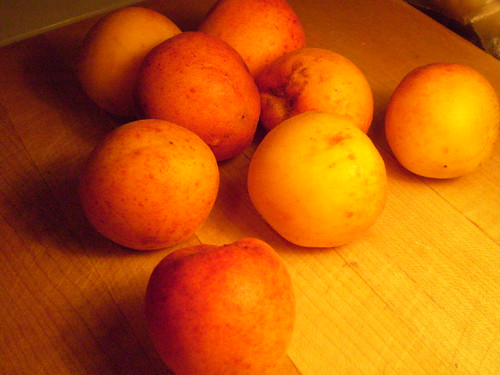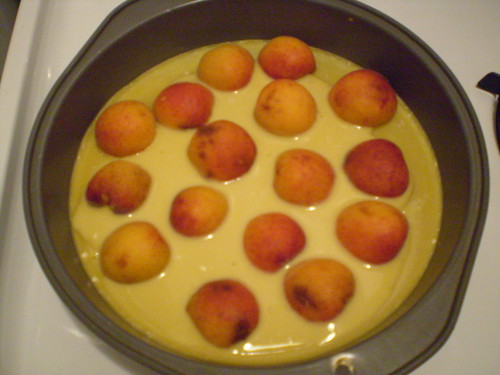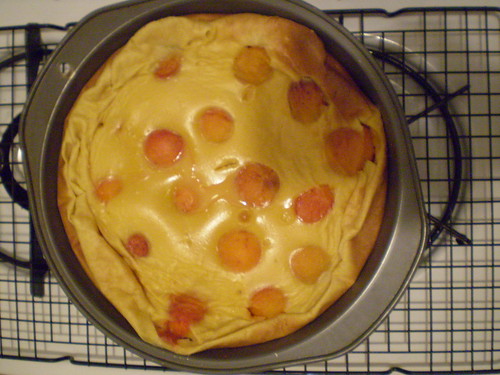Pissaladière-inspired tomato tart
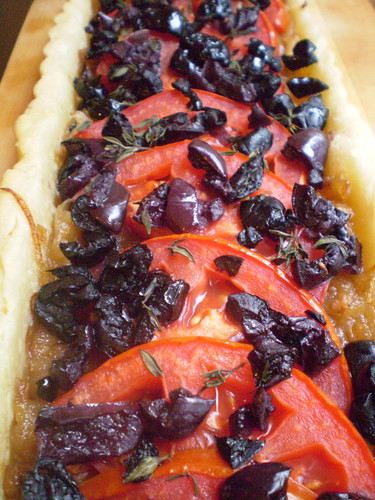 Summer is officially over, but a few juicy red tomatoes who don't want the party to end can still be found hanging about the greenmarket. This is the perfect time to bake something with them now that temperatures have cooled off a bit. That's why my recent attempt at making a pissaladière one Sunday afternoon started looking more like a tomato tart. They were simply stealing the show.
Just because the calendar says the season has officially changed, does not mean that everything on our plates has to instantly turn over as well. I actually hate when people rush the seasons. Christmas decorations in the drugstore for sale right after Halloween are just as silly to me as being served pumpkin soup on a balmy 84 degree day in September. That's why I suggest you ease into the season, even if you're as excited for Fall as I am. Make sure you search the market for any last summer produce, cause you should use what's left of it while you still can.
Summer is officially over, but a few juicy red tomatoes who don't want the party to end can still be found hanging about the greenmarket. This is the perfect time to bake something with them now that temperatures have cooled off a bit. That's why my recent attempt at making a pissaladière one Sunday afternoon started looking more like a tomato tart. They were simply stealing the show.
Just because the calendar says the season has officially changed, does not mean that everything on our plates has to instantly turn over as well. I actually hate when people rush the seasons. Christmas decorations in the drugstore for sale right after Halloween are just as silly to me as being served pumpkin soup on a balmy 84 degree day in September. That's why I suggest you ease into the season, even if you're as excited for Fall as I am. Make sure you search the market for any last summer produce, cause you should use what's left of it while you still can.
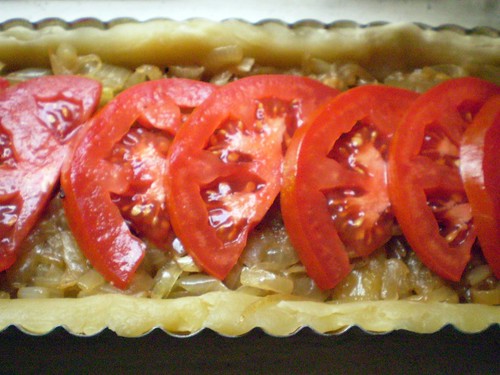 Last weekend, in an effort to think of a fun football watching snack, I decided I was going to try to make a pissaladière, which is a type of "pizza" from the South of France (actually I think that without cheese or tomatoes calling it a pizza is a stretch). Pissaladière sometimes is made into a tart shell and I had prepped the shell about a month ago for such a purpose and left it in my freezer. I took the shell out of the freezer and blind-baked it while I prepared the filling. The recipe I was following was from the Rose Bakery cookbook that had a modern take on the dish. However, just to compare, I pulled out a Cook's Illustrated magazine a friend had given me with a recipe for pissaladière, done the more traditional way, on a pizza-type of dough, free-formed and with anchovies, not tomatoes. I was really tempted to go traditional, but I figured I had all winter to make one that way. I found gorgeous tomatoes at the market on Saturday, and ate a good portion of them with nothing more than a sprinkle of sea salt, while the juices dripped down my hand. The rest were destined for this dish.
Last weekend, in an effort to think of a fun football watching snack, I decided I was going to try to make a pissaladière, which is a type of "pizza" from the South of France (actually I think that without cheese or tomatoes calling it a pizza is a stretch). Pissaladière sometimes is made into a tart shell and I had prepped the shell about a month ago for such a purpose and left it in my freezer. I took the shell out of the freezer and blind-baked it while I prepared the filling. The recipe I was following was from the Rose Bakery cookbook that had a modern take on the dish. However, just to compare, I pulled out a Cook's Illustrated magazine a friend had given me with a recipe for pissaladière, done the more traditional way, on a pizza-type of dough, free-formed and with anchovies, not tomatoes. I was really tempted to go traditional, but I figured I had all winter to make one that way. I found gorgeous tomatoes at the market on Saturday, and ate a good portion of them with nothing more than a sprinkle of sea salt, while the juices dripped down my hand. The rest were destined for this dish.
The filling is pretty simple to assemble once you cook the onions down until they are caramelized and jammy. That takes about 30 minutes, meanwhile pitt and chop some olives and slice your tomatoes. I actually took some hints from the Cook's Illustrated on cooking the onions, figuring someone probably got paid to figure out the nuances of the best method of cooking them down, and I loved the addition of brown sugar. After all was said and done, and the tart was filled and baked, it was an exciting flavor combination with the sweet onions, the briny olives and the bright flavors of the tomatoes. It was a beautiful presentation too, perfect for a side dish at a Sunday dinner perhaps, or an ideal lunch. For football, maybe I should have gone with the pizza-dough method, rather than the tart, because football food should be finger-food, even if it is French inspired.
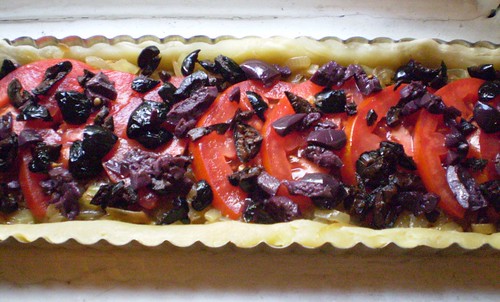
Pissaladière Tomato Tart Adapted from Rose Bakery and Cook's Illustrated. If you don't feel like making a shortcrust tart dough, try the filling on a pizza dough stretched into a long rectangle and adjust baking times.
1 blind baked tart shell (use any shortcrust pastry dough you prefer) 3 tablespoons olive oil 2 lbs. yellow onions, sliced about 1/4 inch thick 1 garlic clove smashed (not chopped or it will burn) 1/2 teaspoon of salt 1 teaspoon brown sugar pinch of ground cinnamon (optional, but adds something interesting) 1 tablespoon water 1 handful olives, pitted and chopped (black olives are traditional, but I used a mixture) 2 tomatoes, sliced few sprigs of fresh thyme
Prepare tart shell, if using by blind baking while you prepare filling.
Slice the onions, and heat olive oil in a large saute pan until hot, but not smoking. Add onions, garlic, salt, brown sugar and cook on med-high heat for about 10 minutes, stirring often. They will look wilted at that point and be starting to brown. Reduce heat to low and cook, until onions are jammy and golden brown, about 20 minutes longer. Take off heat and add the cinnamon and water and stir til incorporated.
While onions are cooking chop and pitt olives, slice tomatoes, and pull prep thyme. (Stretch the pizza dough on a sheet pan, if you're using that instead of tart shell.)
Fill tart shell or cover pizza dough with onions once they're cooked. Lay the tomato slices in on top and sprinkle the whole thing with the thyme leaves and the chopped olives.
Bake the tart at 350 degrees Fahrenheit for about 20 minutes, or until tomatoes look wilted a bit. If using pizza dough, bake until crust is cooked.
